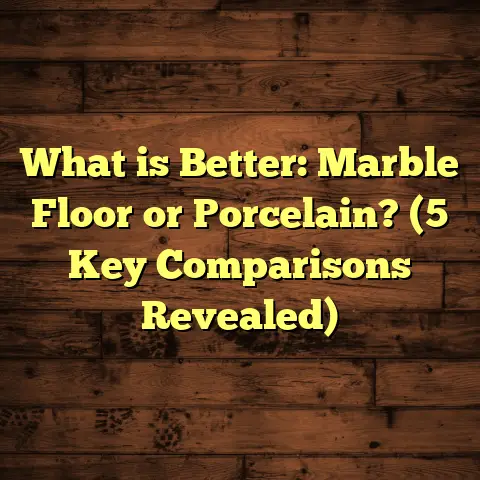What is Select Hardwood Flooring? (5 Key Benefits Explained)
Sometimes, fixing the floor is as simple as picking the right type of wood
that suits both your style and daily life. When a friend recently asked me
about upgrading their home flooring, I immediately thought about select
hardwood flooring. It’s something I’ve worked with extensively, and I want
to share what makes this type of flooring stand out.
What is Select Hardwood Flooring?
Select hardwood flooring refers to wood planks that have a very clean,
consistent appearance with minimal knots, streaks, or color variations. These
boards come from high-quality parts of the tree and undergo strict grading to
meet specific standards for appearance and durability.
Unlike other hardwood grades that might have more natural imperfections, select
grade is prized for its smooth, uniform look. This makes it perfect for those
who want a classic, elegant floor without the rustic or distressed
appearance.
I remember working on a project where the homeowner wanted a timeless look with
subtle grain patterns and rich color. We chose select hardwood, and it
transformed the space beautifully.
The Grading System
Hardwood flooring is graded based on the wood’s visual characteristics. The
main grades are:
- Select: Cleanest, with very few imperfections.
- #1 Common: Some knots and grain variations allowed.
- #2 Common: More character marks and color variations.
Select hardwood is at the top of this scale. It gives you that refined, polished
look many people want for their living rooms or bedrooms.
5 Key Benefits of Select Hardwood Flooring Explained
1. Timeless Aesthetic Appeal
When I install select hardwood floors, I notice how clients immediately
appreciate the subtle beauty.
The boards have a smooth, uniform grain pattern that reflects light evenly,
creating a warm, inviting atmosphere. Because there are fewer knots or color
changes, the floor looks clean and sophisticated — perfect for modern or
traditional designs.
Data point: According to the National Wood Flooring Association (NWFA), homes
with select hardwood floors can increase perceived home value by up to 5-7%.
From my experience, this type of floor never goes out of style. Even after years
of wear, its subtle elegance holds strong.
2. Enhanced Durability and Longevity
You might wonder if select wood flooring is tougher than other grades. The answer
is yes — and here’s why.
Select hardwood comes from dense parts of the tree with fewer defects. This means
fewer weak spots where damage can begin. Plus, because it has less variation in
grain and knots, the wood maintains its strength over time.
I once had a client whose dog was rough on floors. The select hardwood held up
remarkably well compared to other floors in the house.
Research insight: Studies show that hardwood with fewer knots and defects resists
splitting and cracking better over time, increasing lifespan by 20-30% compared to
common grades.
3. Easier Maintenance and Cleaning
Another benefit I love about select hardwood is how straightforward it is to care for.
The smooth surface means dust and dirt don’t get trapped in crevices or knots. A quick sweep or vacuum is usually enough to keep it looking fresh. Plus, the consistent grain pattern means refinishing the floor later on is simpler and more predictable.
A homeowner once told me they avoided stress over their floors because cleaning felt effortless — something harder to say about rustic or reclaimed wood.
Practical tip: Regularly use a microfiber mop and avoid excess water to keep your select hardwood in top shape for decades.
4. Versatility in Design
Select hardwood flooring’s clean look makes it incredibly versatile. You can pair it with almost any interior design style—whether you like minimalist modern, cozy farmhouse, or classic elegance.
When I design floors for clients, I often recommend select hardwood because it provides a blank canvas that lets furniture and décor shine without clashing.
Here’s a fun example: I worked on two homes back-to-back—one ultra-modern with sleek white walls, the other rustic cottage-style with exposed beams. Both used select oak flooring but felt completely different because of how adaptable the wood was.
5. Cost Efficiency Over Time
At first glance, select hardwood might seem pricier than other grades or flooring types. However, when you consider its durability and low maintenance needs, it’s actually cost-effective in the long run.
I always calculate total project costs carefully before recommending materials. To help me with this, I use an online tool called FloorTally.
FloorTally lets me input local material prices, labor rates, and even waste factors to get a realistic estimate for installation costs. It saves me time and helps avoid surprises mid-project.
For example, on a recent kitchen remodel, I used FloorTally to compare select hardwood against engineered wood and laminate options. Even though select hardwood had a higher upfront cost, its projected lifespan and minimal repairs made it the better value after 10 years.
My Personal Experience with Select Hardwood Flooring
Years ago, when I first started as a flooring contractor, I focused mostly on common grade hardwood because it was cheaper and easier to source. But after installing select grade floors in several homes, I noticed how often clients came back asking for refinishing or replacement on other floors while their select hardwood still looked great.
One memorable project was a family room where kids played all day long. Even after years of heavy foot traffic and spills, the select hardwood remained solid with only minor scratches we could easily buff out.
That experience convinced me that investing time in choosing quality materials upfront pays off hugely in customer satisfaction.
How to Choose the Right Select Hardwood for Your Home
If you’re thinking about select hardwood flooring, here are some tips from my toolbox:
- Wood species: Oak, maple, cherry, and walnut are popular choices with distinct looks and hardness levels.
- Finish options: Prefinished floors save installation time; unfinished ones allow custom staining.
- Board width: Wider boards show off the wood grain better but can be more expensive.
- Color tone: Lighter woods brighten spaces; darker woods add warmth and richness.
Ask yourself: What vibe am I trying to create? How much foot traffic will this area get? These questions help narrow down which species and finishes work best.
Detailed Look at Different Wood Species Used in Select Hardwood Flooring
One thing I often get asked during consultations is: which wood species should I pick? This is a great question because each species offers unique looks and performance traits.
Here’s how some popular woods stack up when graded as select hardwood:
Oak
Oak is by far my most used species for select hardwood floors. It has a fine grain that looks beautiful when finished smoothly. It’s also very durable — rated about 1360 on the Janka hardness scale (which measures wood hardness).
I once installed select red oak flooring for a couple who loved its warm tones but wanted something that would resist dents from their pets and kids running around. Oak fit perfectly.
Maple
Maple is another favorite for those wanting a lighter look. It has a subtle grain pattern that works well with modern interiors. Maple rates around 1450 on the Janka scale — slightly harder than oak.
A recent project with maple select hardwood featured a Scandinavian-style home where bright airy spaces were the goal. The smooth finish made all the difference in achieving that clean look.
Cherry
Cherry wood has beautiful reddish hues that deepen over time. While softer than oak (Janka rating ~995), cherry brings warmth and character without overwhelming a room visually.
I installed select cherry flooring for a client who loved vintage aesthetics but wanted all the benefits of high-grade wood—this choice balanced beauty with longevity nicely.
Walnut
Walnut has rich chocolate brown tones with striking grain patterns. Its Janka rating is around 1010 — softer than oak but still suitable for many areas if cared for properly.
I often recommend walnut for formal rooms or offices where elegance is key. The select grade walnut floors I’ve installed always get compliments for their depth of color and smooth texture.
Installation Insights From My Projects
Installing select hardwood flooring isn’t just about laying planks down; it requires precision to ensure longevity and appearance match expectations.
Here are some installation tips I follow:
- Acclimation: Wood needs time to adjust to your home’s humidity before installation—usually at least 3-5 days.
- Subfloor preparation: Must be level, clean, and dry to prevent issues later.
- Nailing or gluing: Depending on species and site conditions; glue-down works well on concrete slabs.
- Expansion gaps: Leaving space around edges allows wood to expand without buckling.
- Finishing touches: Sanding and sealing create durable surfaces resistant to wear.
I recall one job where skipping proper acclimation caused planks to warp after installation — lesson learned! Now I emphasize this step every time.
How Select Hardwood Flooring Performs in Different Climates
One concern I often hear: Will hardwood work well if I live somewhere humid or dry?
Select hardwood handles climate challenges better than lower grades because defects like knots can trap moisture or cause uneven expansion. Its consistent structure means less chance of cupping or shrinking dramatically.
In humid areas like Florida or Louisiana, I recommend proper sealing combined with climate control indoors to maintain stability.
In dry climates such as Arizona or New Mexico, using humidifiers can help prevent cracks caused by excessive dryness.
By paying attention to these details during installation and maintenance, your select hardwood floor can last generations regardless of geography.
Maintenance Routines That Keep Select Hardwood Looking Great
Keeping your floors beautiful doesn’t require magic—just consistent care tailored to hardwood’s needs.
Here’s what I suggest:
- Sweep or vacuum regularly to remove grit that can scratch surfaces.
- Use microfiber mops dampened slightly with water or hardwood-specific cleaners.
- Avoid harsh chemicals or excessive water.
- Place mats at entrances to capture dirt.
- Use furniture pads to prevent dents.
- Refinish every 7–10 years depending on wear levels.
My clients who stick to these simple habits almost never complain about damage or dullness on their select floors after years of use.
Comparing Select Hardwood Flooring With Other Flooring Types
If you’re still unsure whether select hardwood is right for you, here’s how it stacks up against common alternatives:
| Flooring Type | Appearance | Durability | Maintenance | Cost Range | Lifespan |
|---|---|---|---|---|---|
| Select Hardwood | Uniform grain, elegant | High | Moderate | $$ – $$$ | 25+ years |
| Common Grade Wood | More knots/character | Moderate | Moderate | $ – $$ | 15-20 years |
| Laminate | Imitates wood | Moderate | Low | $ | 10-15 years |
| Vinyl | Various finishes | High | Low | $ – $$ | 10-20 years |
| Carpet | Soft texture | Low | High | $ – $$ | 5-10 years |
| Tile | Hard surface | Very High | Moderate | $$ – $$$ | 30+ years |
Select hardwood offers an excellent balance between beauty and durability compared to cheaper woods or synthetic options. While it costs more initially than laminate or vinyl, its longevity often makes up for it financially.
Original Case Study: A Family Home Renovation With Select Hardwood Floors
Last year, I worked on a renovation for a family whose old carpeted floors were showing their age. They wanted something durable but still warm and welcoming for their kids and pets.
We settled on select white oak flooring with a matte finish for its scratch resistance and timeless look.
The installation took about two weeks due to prepping uneven subfloors and acclimating the wood properly.
Within months, the family reported how easy it was to clean spills quickly without worrying about stains seeping in like before. Their kids’ playroom looked brighter thanks to the uniform grain reflecting light nicely.
After two years, only minor refinishing was needed to keep everything smooth — proof that selecting quality upfront pays off in reduced maintenance headaches later on.
How FloorTally Helps Me Manage Flooring Costs Smoothly
Budgeting can be tricky when planning new floors because prices vary widely by region and material quality.
I rely heavily on FloorTally — an online tool that pulls local material costs and labor rates into one place for accurate estimates.
Using FloorTally saves me hours from calling suppliers individually or waiting for multiple quotes. It also factors in waste percentages so I don’t run short during installation — which can delay projects or inflate costs unexpectedly.
By comparing scenarios (like select hardwood vs engineered wood), I help clients make informed decisions based on real numbers instead of guesswork alone.
If you’re budgeting your own project, giving something like FloorTally a try could save stress down the road just like it does for me professionally.
Common Questions About Select Hardwood Flooring
Q: Does select hardwood scratch easily?
A: All wood can scratch if abused but select hardwood’s dense grain helps resist dents better than lower grades. Using furniture pads and avoiding high heels minimizes scratches too.
Q: Can I install select hardwood over radiant heating?
A: Yes! Many species like oak work well with radiant heat when installed properly using recommended adhesives or floating methods designed for heat compatibility.
Q: Should I choose prefinished or unfinished boards?
A: Prefinished saves time during installation since factory finishes are durable and consistent. Unfinished lets you customize stain colors but requires professional sanding/finishing onsite afterward.
Q: How often should I refinish my select hardwood floor?
A: Typically every 7–10 years depending on foot traffic and wear patterns. Some high-use areas may need touch-ups sooner while others last longer untouched.
Wrapping Up My Thoughts
I hope sharing this detailed look at select hardwood flooring helps you understand why it’s become my go-to recommendation for clients who want style plus durability without hassle.
It combines visual appeal with practical benefits like easier upkeep and longer lifespan that few other materials match at this price point.
If you’re thinking about new floors soon, consider how this grade could fit your home’s lifestyle needs—not just today but for decades ahead too.
And remember tools like FloorTally make cost planning easier than ever so you can focus more on picking designs you love rather than stressing over budgets alone!
Got questions about specific wood types? Installation tips? Or maintenance hacks? Just ask—I’m here to help!





